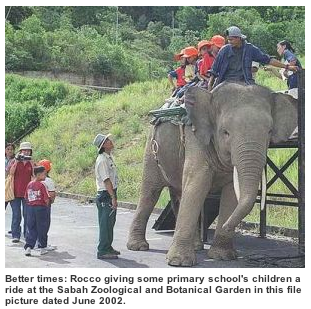Rocco the Borneo Pygmy Elephant died at 27
I read the news from the TheStar on the 23rd Feb that a Borneo Pygmy Elephant had died.
Rocco was 27 years old died due to recumbence a prolonged lying according to the Sabah Wildlife Dept senior veterinarian Dr. Sen Nathan.
Remembering Rocco
I took these Pygmy Elephant photos last year when I visited Lok Kawi Wildlife Park.
RIP Rocco
no images were found


9 responses to “Tribute to Borneo Pygmy Elephant”
http://jong.my/2010/07/06/picture-of-the-day-10-elephant-lok-kawi-wildlife-park-kota-kinabalu
this elephant tusks look the same, not sharp.
@Daisy Thank you
@Lizzy Yes he did
@The Envoy I’m not the expert looks like Lulu already got the answer ahhaha Long time no see you! cheers
@Lulu Thank you
@Nino Thanks Bro!
RIP Rocco.
Looks like its tusks have been cut off.
I dont think they were
thats a comparison between african and asian elephant tusks, thus a pygmy may have relatively smaller tusks than large species
some additional facts from wikipedia:
“The tusks of an elephant are its second upper incisors. Tusks grow continuously; an adult male’s tusks grow about 18 cm (7 in) a year. Tusks are used to dig for water, salt, and roots; to debark trees to eat the bark; to dig into baobab trees to get at the pulp inside; and to move trees and branches when clearing a path. In addition, they are used for marking trees to establish territory, and occasionally as weapons.
Like humans who are typically right- or left-handed, elephants are usually right- or left-tusked. The dominant tusk, called the master tusk, is generally shorter and more rounded at the tip from wear. Both male and female African elephants have large tusks that can reach over 3 m (10 ft) in length and weigh over 90 kg (200 lb). In the Asian species, only the males have large tusks. Female Asians have tusks which are very small or absent altogether. Asian males can have tusks as long as the much larger Africans, but they are usually much slimmer and lighter; the heaviest recorded is 39 kg (86 lb). The tusk of both species is mostly made of calcium phosphate in the form of apatite. As a piece of living tissue, it is relatively soft (compared with other minerals such as rock), and the tusk, also known as ivory, is strongly favoured by artists for its carvability. The desire for elephant ivory has been one of the major factors in the reduction of the world’s elephant population.”
rocco looked happy!!
Aw…sad that he died. You took some great pictures of him, Netster. 🙂
[New Post] Tribute to Borneo Pygmy Elephant http://jong.my/2011/02/26/tribute-to-bor… #photography #borneo #
RT @netster23: [New Post] Tribute to Borneo Pygmy Elephant http://jong.my/2011/02/26/tribute-to-bor… #photography #borneo #